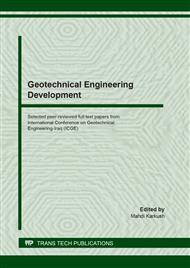p.66
p.74
p.83
p.89
p.99
p.109
p.120
p.130
p.138
Numerical Modeling of Reinforced Concrete Slabs under Impact Loading
Abstract:
This paper aims to provide a numerical model able to represent the behavior of reinforced concrete slabs subjected to impact loads. The nonlinear finite element analysis adopted by ABAQUS/Explicit Software was used in this study. A parametric study was conducted to provide a comprehensive understanding of the behavior of reinforced concrete slabs subjected to impact load. Two parameters were varied amongst the slabs which classified in to two groups. In the first groups, the thickness of slabs is variable, which was equal to (75, 100, 150 mm). In the second group, the thickness of the slab is constant and the variable was the reinforcement ratio, which ranged from (0.58 to 1%), per layer. In dynamic analysis, the load-time history and deflection-time relation were investigated. For the first group, obviously, as the slab thickness increased, the maximum central deflection of the slabs decreased by (48 – 84 %). Also, the impact force of the slabs increased by (40 – 106%) as the thickness of the slab increased by (33 – 100%). For the second group, the maximum central deflection of the slabs decreased by (6.6 – 8.8 %) as the steel reinforcement increased by (0.58 – 1 %). It was observed in the second group that the change in the value of the impact force was very limited. This lead to a fact that the impact force was not affected by the change of the reinforcement ratio, but mainly affected by the change of the slab thickness.
Info:
Periodical:
Pages:
99-108
Citation:
Online since:
August 2020
Authors:
Keywords:
Price:
Сopyright:
© 2020 Trans Tech Publications Ltd. All Rights Reserved
Share:
Citation:


